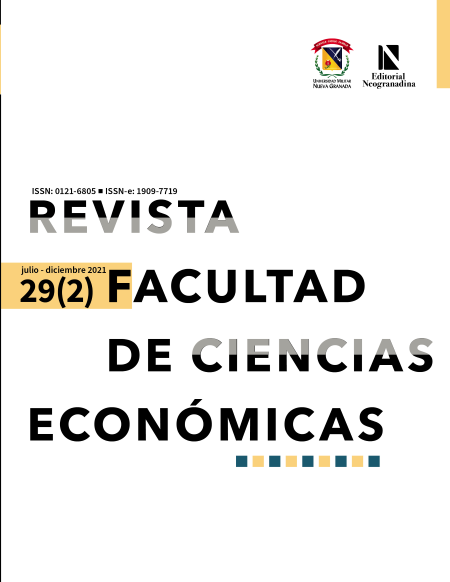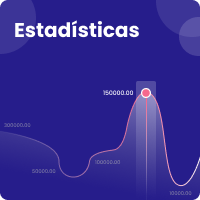La tasa de cambio y sus impactos en los agregados económicos colombianos
una aproximación FAVAR
Resumen
Este documento identifica la relación existente entre la tasa de cambio y los diferentes agregados macroeconómicos en la economía colombiana, principalmente en la producción, el consumo, la inflación, la balanza comercial, la tasa de desempleo y la inversión, a través de la metodología Factor Augmented var (FAVAR). Se identifica que una apreciación del dólar genera cambios significativos sobre la actividad económica, la balanza comercial, los precios, el consumo y el gasto público.
Descargas
Referencias bibliográficas
Alonso, G., Hernández, J. N., Pulido, J. D. y Villa, M. (2008). Medidas alternativas de tasa de cambio real para Colombia (Borradores de Economía, 514, 20-81). Banco de la República. https://doi.org/10.32468/be.514
Balke, N. S., Brown, S. y Yücel, M. (2002). Oil price shocks and the U.S. Economy: Where does the asymmetry originate? Energy Journal, 23(3), 27-52. https://doi.org/10.5547/ISSN0195-6574-EJ-Vol23-No3-2
Bai, J. y Ng, S. (2002). Determining the Number of Factors in Approximate Factor Models. Econometrica, 70(1), 191-221. https://doi.org/10.1111/1468-0262.00273
Banco de la República, Colombia. (s. f.). Índice de la tasa de cambio real (itcr). https://www.banrep.gov.co/es/estadisticas/tasas-de-cambio-sector-externo-y-derivados
Bergstrand, J. H. (1985). The Gravity Equation in International Trade: Some Microeconomic Foundations and Empirical Evidence. Review of Economics and Statistics, 67(3), 474-481. https://doi.org/10.2307/1925976
Bernanke, B. S., Boivin, J. y Eliasz, P. (2005). Measuring the Effects of Monetary Policy: A Factor-Augmented Vector Autoregressive (favar) approach. The Quarterly Journal of Economics, 120(1), 387-422. https://doi.org/10.1162/0033553053327452
Bernanke, B. S. (1983). Irreversibility, Uncertainty, and Cyclical Investment. Journal of Economics, (98)1, 85-106. https://doi.org/10.2307/1885568
Branson, W. H. y Love, J. P. (1988). The Real Exchange Rate, Employment and Output in Manufacturing in the U.S. and Japan. National Bureau of Economic Research, Working Paper 2491. https://doi.org/10.3386/w2491
Bjørnland, H. C. (2003). The Economic Effects of North Sea Oil on the Manufacturing Sector. Scottish Journal of Political Economy, 45(5), 553-585. https://doi.org/10.1111/1467-9485.00112
Burgess, S. M. y Knetter, M. M. (1998). An International Comparison of Employment Adjustment to Exchange Rate Fluctuations. Review of International Economics, 6(1), 151-163. https://doi.org/10.1111/1467-9396.00094
Candelo, J. M. (2021). Índice mensual de incertidumbre financiera y económica (imife) para la economía colombiana. Lecturas de Economía, (95). https://doi.org/10.17533/udea.le.n95a343318
Candelo, J. M. (2018). Impactos indirectos de la tasa de cambio y los precios del petróleo en una economía no petrolera: aproximaciones vecm y var para el Valle del Cauca, Colombia. Finanzas y Política Económica, 10(2), 403-436. https://doi.org/10.14718/revfinanzpolitecon.2018.10.2.9
Clarida, R.; Galí J. y Gertler, M. (2001). Optimal Monetary Policy in Open versus Closed Economies: An Integrated Approach. American Economic Review, (91)2, 248-52. https://doi.org/10.1257/aer.91.2.248
Corden, W. M. (1984). Booming Sector and Dutch Disease Economics: Survey and Consolidation. Oxford Economic Papers, 36(3), 359-380. https://doi.org/10.1093/oxfordjournals.oep.a041643
Corsetti, G.; Dedola, L. y Leduc, S. (2010). Optimal Monetary Policy in Open Economies. En B. M. Friedman y M. Woodford, (Eds.), Handbook of Monetary Economics, vol. 3, (pp. 861-933). Elsevier. https://doi.org/10.1016/B978-0-444-53454-5.00004-9
dane. (s. f). Cuentas nacionales anuales. https://www.dane.gov.co/index.php/estadisticas-por-tema/cuentas-nacionales
Davis, S. J. y Haltiwanger, J. (2001). Sectoral job creation and destruction responses to oil price changes. Journal of Monetary Economics, 48(3), 465-512. https://doi.org/10.1016/S0304-3932(01)00086-1
Demir, F. (2010). Exchange Rate Volatility and Employment Growth in Developing Countries: Evidence from Turkey. World Development, 38(8), 1127–1140. https://doi.org/10.1016/j.worlddev.2009.12.019
Dickey, D. A. y Fuller, W. A. (1979/2012). Distribution of the Estimators for Autoregressive Time Series with a Unit Root. Journal of the American Statistical Association, 74(366a), 427- 431. https://doi.org/10.1080/01621459.1979.10482531
Dozovic, E. y Pripuzic, D. (2013). Industry Specific Real Effective Exchange Rates in Central and Eastern European Countries [conferencia]. The 8th Young economists’ seminar to 19th Dubrovnik Economic Conference, Croacia, https://www.hnb.hr/documents/20182/120691/dozovic-pripuzic2.pdf/63f6396a-3ad0-4118-98cd-fbb36a8c3142.
Echavarría, J. J. y Arbeláez, M. A. (2003). Tasa de cambio y crecimiento económico en Colombia durante la última década. (Borradores de Economía, 338). Banco de la República. https://www.banrep.gov.co/docum/ftp/borra338.pdf
Égert, B. y Leonard, C. (2008). The Dutch disease in Kazakhstan: An empirical investigation. Focus on European Economic Integration, (2), 85-108.
Forni, M., Hallin, M., Lippi, M. y Reichlin, L. (2005). The Generalized Dynamic Factor Model: One-Sided Estimation and Forecasting. Journal of the American Statistical Association, 100(471), 830-840. https://doi.org/10.1198/016214504000002050
Frenkel, R. y Ros, J. (2006). Unemployment and the real exchange rate in Latin America. World Development, 34(4), 631-646. https://doi.org/10.1016/j.worlddev.2005.09.007
Galindo, A., Izquierdo, A. y Montero, J. M. (2007). Real exchange rates, dollarization and industrial employment in Latin America. Emerging Markets Review, 8(4), 284–298. https://doi.org/10.1016/j.ememar.2006.11.002
Geweke, J. (1976). The dynamic factor analysis of economic time series models. University of Wisconsin, 22(1), 37-54.
González, S. y Hernández, E. (2016). Impactos indirectos de los precios del petróleo en el crecimiento económico colombiano. Lecturas de Economía, (84), 103-141. https://doi.org/10.17533/udea.le.n84a04
Guzman, M., Ocampo, J. A. y Stiglitz, J. E. (2018). Real exchange rate policies for economic development. World Development, 110, 51-62. https://doi.org/10.1016/j.worlddev.2018.05.017
Hamilton, J. D. (2003). What is an oil shock? Journal of Econometrics, 113(2), 363-398. https://doi.org/10.1016/S0304-4076(02)00207-5
Hamilton, J. D. (1989). A New Approach to the Economic Analysis of Nonstationary Time Series and the Business Cycle. Econometrica, 52(7), 357-384. https://doi.org/10.2307/1912559
Haltiwanger J., Kugler, A., Kugler, M., Micco, A. y Pagés, C. (2004). Effects of tariffs and real exchange rates on job reallocation: evidence from Latin America. The Journal of Policy Reform, 7(4), 191-208. https://doi.org/10.1080/1384128042000285183
Hua, P. (2007). Real exchange rate and manufacturing employment in China. China Economic Review, 18(3), 335–353. https://doi.org/10.1016/j.chieco.2007.02.001
International Monetary Fund (imf). (s. f.) World economic outlook databases. https://www.imf.org/en/Publications/SPROLLS/world-economic-outlook-databases#sort=%40imfdate%20descending
Kilian, L. y Vigfusson, R. (2011). Are the responses of the u.s. economy asymmetric in energy price increases and decreases? Quantitative Economics, 2. https://doi.org/10.3982/QE99
Kilian, L. (2009). Not All Oil Price Shocks Are Alike: Disentangling Demand and Supply Shocks in the Crude Oil Market. American Economic Review, 99(3), 1053-69. https://doi.org/10.1257/aer.99.3.1053
Lartey, E. (2008). Capital Inflows, Resource Reallocation and the Real Exchange Rate. International Finance, 11(2), 131-152. https://doi.org/10.1111/j.1468-2362.2008.01222.x
Lee, K., Ni, S., Ratti, R.A., 1995. Oil Shocks and the Macroeconomy: The Role of Price Variability. Energy Journal, 16(4), 39-56. https://doi.org/10.5547/ISSN0195-6574-EJ-Vol16-No4-2
Leung, D. y Yuen, T. (2007). Labour Market Adjustments to Exchange Rate Fluctuations: Evidence from Canadian from Canadian Manufacturing Industries. Open Economies Review, 18(2), 177-189. https://doi.org/10.1007/s11079-007-9007-y
Mendoza, O. y Vera, D. (2010). The Asymmetric Effects of Oil Shocks on an Oil-Exporting Economy. Cuadernos de Economía, 47(135), 3-13. https://doi.org/10.4067/S0717-68212010000100001
Gov.co, (s. f.). Cifras, datos e indicadores. https://www.minhacienda.gov.co/webcenter/portal/Estadisticas
Mork, K. A. (1989). Oil and the Macroeconomy When Prices Go Up and Down: An Extension of Hamilton’s Results. Journal of Political Economy, 97(3), 740-744. https://doi.org/10.1086/261625
Mork, K. A., Olsen, O. y Mysen, H. T. (1994). Macroeconomic Responses to Oil Price Increases and Decreases in Seven oecd Countries. The Energy Journal, 15(4). https://doi.org/10.5547/ISSN0195-6574-EJ-Vol15-No4-2
Neary, P. (1988). Determinants of the equilibrium real exchange rate. American Economic Review, 78(1), 210-215. https://www.jstor.org/stable/1814708
Ostry, J. D. (1988). The Balance of Trade, Terms of Trade, and Real Exchange Rate: An Intertemporal Optimizing Framework. imf Staff Papers, 35(4), 541-573. https://doi.org/10.2307/3867110
Otero, J. (1997). Los determinantes de la tasa de cambio real en Colombia. Coyuntura Económica, 169-180. http://hdl.handle.net/11445/3267
Oviedo-Gómez, A. y Candelo-Viafara, J. M. (2020). Mining and Energy Commodity Price Effects on Colombian Economy. Cuadernos de Administración, 36(67), 93-108. https://doi.org/10.25100/cdea.v36i67.8641
Oviedo, A. F. y Sierra, L. P. (2019). La importancia de los términos de intercambio en la economía colombiana. Revista de la Cepal, (128), 125-154. https://doi.org/10.18356/73298cb5-es
Peláez, J. T. y Sierra, L. P. (2016). Does Industrial Employment React to Movements in the Real Exchange Rate? An Empirical Analysis for Colombia, 2000-2010. Latin American Journal of Economics, 53(1), 36-39. http://dx.doi.org/10.7764/LAJE.53.1.39
Perilla, J. R. (2010). El impacto de los precios del petróleo sobre el crecimiento económico en Colombia. Revista de Economía del Rosario, 13(1), 75-116.
Phillips, P. C. y Perron, P. (1988). Testing for a unit root in time series regression. Biometrika, 75(2), 335-346. https://doi.org/10.1093/biomet/75.2.335
Pindyck, R. S. (1991). Irreversibility, Uncertainty, and Investment. Journal of Economic Literature, 29, 1110-1148. https://doi.org/10.3386/w3307
Poncela, P., Senra, E. y Sierra, L. P. (2017). Long-term links between raw materials prices, real exchange rate and relative de-industrialization in a commodity-dependent economy: empirical evidence of “Dutch disease” in Colombia. Empirical Economics, 52(2), 777-798. https://doi.org/10.1007/s00181-016-1083-7
Reinhart, C. M. (1995). Devaluation, Relative Prices and International Trade: Evidence from Developing Countries. Staff Papers (International Monetary Fund), 42(2), 290-312. https://doi.org/10.2307/3867574
Revenga, A. (1992). Exporting Jobs? The Impact of Import Competition on Employment and Wages in U. S. Manufacturing. The Quarterly Journal of Economics, 107(1), 255–284. https://doi.org/10.2307/2118329
Rhenals, R. y Saldarriaga, J. (2007). Tasa de cambio real y crecimiento económico en Colombia, 1995-2006: Una exploración inicial. Perfil de Coyuntura Económica, (9), 5-19.
Sahin, A. y Cengiz, S. (2011). The real exchange rate and the employment market: Evidence for Turkey by panel cointegration analysis. African Journal of Business Management, 5(14), 5845–5854. https://doi.org/10.5897/AJBM10.1162
Sierra, L. P. y Manrique, L. (2014). Impacto del tipo de cambio real en los sectores industriales de Colombia: una primera aproximación. Revista de la Cepal, 114, 127-142. https://doi.org/10.18356/4f500c15-es
Sinnott, E., Nash, J. y De la Torre, A. (2011). Natural Resources in Latin America and the Caribbean: Beyond Booms and Busts? World Bank Latin American and Caribbean Studies. World Bank. https://doi.org/10.1596/978-0-8213-8482-4
Stock, J. H. y Watson, M. W. (2011). Dynamic Factor Models. En M. P. Clements y D. F. Hendry. (Eds.), Oxford Handbook on Economic Forecasting (35-59). Oxford University Press. https://doi.org/10.1093/oxfordhb/9780195398649.013.0003
Stock, J. H. y Watson, M. W. (2005). Implications of dynamic factor models for var analysis. National Bureau of Economic Research, 11467, 1-67.
Stock, J. H. y Watson, M. W. (2002). Macroeconomic Forecasting Using Diffusion Indexes. Journal of Business & Economic Statistics, 20(2), 147-162. https://doi.org/10.1198/073500102317351921
Svensson, L. E. O. (2000). Open-Economy Inflation Targeting. Journal of International Economics, 50(1), 155-83. https://doi.org/10.1016/S0022-1996(98)00078-6
Vergara, S. (2005). Dinámica laboral de la industria en Chile. Revista de la Cepal, (86), 147-166. https://doi.org/10.18356/de1e3ce1-es












